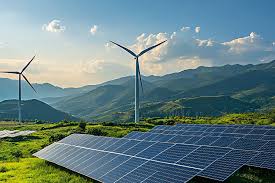
India is taking steps to ensure that its ambitious renewable energy expansion aligns with real-time electricity demand, aiming to prevent inefficiencies and unprofitable infrastructure investments. Authorities have warned that the rapid addition of renewable capacity without corresponding market absorption could create a surplus of idle assets and strain the power grid. The move is part of a broader strategy to create a more balanced and resilient energy system while supporting India’s clean energy transition goals.
Balancing Capacity with Consumption
The Central Electricity Authority (CEA) has emphasized the risks of overbuilding renewable capacity without careful coordination with demand projections. With nearly 44 gigawatts of renewable power projects currently lacking supply agreements, there is growing concern that newly added capacity could remain underutilized. Officials caution that simply constructing additional solar and wind farms does not guarantee that generated power will reach consumers.
Grid operators have already faced challenges in maintaining system balance, sometimes being forced to curtail power injections due to mismatches between generation and consumption. Analysts warn that overcapacity could replicate past challenges seen in thermal power generation, where excess supply led to financial stress for several companies and even bankruptcy in extreme cases.
Officials are urging developers to submit grid connection requests well in advance—typically 24 to 36 months before commissioning—to allow for the necessary infrastructure and coordination. Ensuring that power lines, substations, and transmission networks are prepared in tandem with generation capacity is critical to preventing idle assets and lost revenue. Certain substations, such as the 4,000-megawatt facility in Khavda, Gujarat, have only a fraction of their potential capacity actively connected to renewable projects, highlighting gaps in planning and integration.
Enhancing Transmission and Infrastructure Coordination
While India has made significant progress in scaling up renewable energy generation, industry experts point to lagging investment in transmission infrastructure as a bottleneck. The ability to transport electricity from generation sites to end-users is essential for the efficiency and profitability of renewable projects. Developers have called for more comprehensive reforms in transmission planning and execution, arguing that generation and distribution must advance at the same pace to maximize the benefits of clean energy investments.
The government’s push for better coordination includes reviewing interconnection timelines, enhancing grid capacity, and optimizing load management. By synchronizing generation with transmission upgrades, India aims to minimize curtailment, improve system stability, and protect developers from the financial risks of stranded assets.
Industry leaders also stress the importance of forward-looking demand projections. Forecasting electricity consumption patterns, especially in industrial, commercial, and residential segments, will allow developers to strategically deploy renewable capacity where it is most needed. By closely tracking growth in demand, India hopes to avoid the pitfalls of previous overcapacity periods, particularly in conventional power plants, and ensure a more efficient and market-responsive energy ecosystem.
Strategic Goals for a Sustainable Energy Future
Aligning renewable energy growth with demand is part of India’s broader strategy to strengthen energy security and promote sustainable development. By integrating supply and demand planning, the country aims to enhance financial viability for developers, increase investor confidence, and accelerate the transition to low-carbon energy.
Officials have highlighted that well-timed renewable deployment can help stabilize electricity prices, improve grid reliability, and reduce dependency on fossil fuels. By ensuring that new projects come online only where demand exists or can be stimulated, India can maximize the impact of every megawatt of clean energy produced.
The government also sees the approach as critical for meeting climate and energy targets. India has committed to achieving net-zero emissions by 2070 and scaling renewable energy to over 500 gigawatts by the early 2030s. Efficient integration of generation and transmission will play a key role in attaining these goals while minimizing wasted capacity and reducing financial risk for developers.
Investment in modern grid technologies, including smart grids, energy storage, and real-time monitoring systems, is also expected to complement the strategy. By enabling better demand-response management, India can absorb intermittent renewable generation more effectively and optimize energy flows across regions.
The push for demand-aligned expansion is being reinforced through policy guidance, industry consultations, and regulatory updates. Authorities are working with developers, grid operators, and investors to establish best practices in project planning, interconnection, and commercial operation. The aim is to create a resilient ecosystem where renewable energy growth is sustainable, financially viable, and responsive to market needs.
By coordinating capacity addition with realistic demand projections, India hopes to prevent overcapacity in its clean energy sector, reduce curtailment risks, and protect developers from financial losses. The approach also positions the country to attract further investment in renewable infrastructure, bolster energy security, and meet ambitious climate commitments.
As the renewable energy sector continues to expand rapidly, aligning growth with demand will be essential for maintaining system reliability, optimizing infrastructure utilization, and achieving a sustainable energy transition. India’s renewed focus on strategic planning, efficient grid integration, and demand-driven development reflects its commitment to building a robust and future-ready clean energy ecosystem.
In essence, the government’s guidance is designed to create a harmonious balance between supply and demand, ensuring that India’s renewable energy trajectory remains both ambitious and practical. By synchronizing generation, transmission, and consumption, the country is aiming for a future in which clean energy contributes efficiently to the economy while supporting environmental sustainability and long-term energy security.
(Source:www.reuters.com)
Balancing Capacity with Consumption
The Central Electricity Authority (CEA) has emphasized the risks of overbuilding renewable capacity without careful coordination with demand projections. With nearly 44 gigawatts of renewable power projects currently lacking supply agreements, there is growing concern that newly added capacity could remain underutilized. Officials caution that simply constructing additional solar and wind farms does not guarantee that generated power will reach consumers.
Grid operators have already faced challenges in maintaining system balance, sometimes being forced to curtail power injections due to mismatches between generation and consumption. Analysts warn that overcapacity could replicate past challenges seen in thermal power generation, where excess supply led to financial stress for several companies and even bankruptcy in extreme cases.
Officials are urging developers to submit grid connection requests well in advance—typically 24 to 36 months before commissioning—to allow for the necessary infrastructure and coordination. Ensuring that power lines, substations, and transmission networks are prepared in tandem with generation capacity is critical to preventing idle assets and lost revenue. Certain substations, such as the 4,000-megawatt facility in Khavda, Gujarat, have only a fraction of their potential capacity actively connected to renewable projects, highlighting gaps in planning and integration.
Enhancing Transmission and Infrastructure Coordination
While India has made significant progress in scaling up renewable energy generation, industry experts point to lagging investment in transmission infrastructure as a bottleneck. The ability to transport electricity from generation sites to end-users is essential for the efficiency and profitability of renewable projects. Developers have called for more comprehensive reforms in transmission planning and execution, arguing that generation and distribution must advance at the same pace to maximize the benefits of clean energy investments.
The government’s push for better coordination includes reviewing interconnection timelines, enhancing grid capacity, and optimizing load management. By synchronizing generation with transmission upgrades, India aims to minimize curtailment, improve system stability, and protect developers from the financial risks of stranded assets.
Industry leaders also stress the importance of forward-looking demand projections. Forecasting electricity consumption patterns, especially in industrial, commercial, and residential segments, will allow developers to strategically deploy renewable capacity where it is most needed. By closely tracking growth in demand, India hopes to avoid the pitfalls of previous overcapacity periods, particularly in conventional power plants, and ensure a more efficient and market-responsive energy ecosystem.
Strategic Goals for a Sustainable Energy Future
Aligning renewable energy growth with demand is part of India’s broader strategy to strengthen energy security and promote sustainable development. By integrating supply and demand planning, the country aims to enhance financial viability for developers, increase investor confidence, and accelerate the transition to low-carbon energy.
Officials have highlighted that well-timed renewable deployment can help stabilize electricity prices, improve grid reliability, and reduce dependency on fossil fuels. By ensuring that new projects come online only where demand exists or can be stimulated, India can maximize the impact of every megawatt of clean energy produced.
The government also sees the approach as critical for meeting climate and energy targets. India has committed to achieving net-zero emissions by 2070 and scaling renewable energy to over 500 gigawatts by the early 2030s. Efficient integration of generation and transmission will play a key role in attaining these goals while minimizing wasted capacity and reducing financial risk for developers.
Investment in modern grid technologies, including smart grids, energy storage, and real-time monitoring systems, is also expected to complement the strategy. By enabling better demand-response management, India can absorb intermittent renewable generation more effectively and optimize energy flows across regions.
The push for demand-aligned expansion is being reinforced through policy guidance, industry consultations, and regulatory updates. Authorities are working with developers, grid operators, and investors to establish best practices in project planning, interconnection, and commercial operation. The aim is to create a resilient ecosystem where renewable energy growth is sustainable, financially viable, and responsive to market needs.
By coordinating capacity addition with realistic demand projections, India hopes to prevent overcapacity in its clean energy sector, reduce curtailment risks, and protect developers from financial losses. The approach also positions the country to attract further investment in renewable infrastructure, bolster energy security, and meet ambitious climate commitments.
As the renewable energy sector continues to expand rapidly, aligning growth with demand will be essential for maintaining system reliability, optimizing infrastructure utilization, and achieving a sustainable energy transition. India’s renewed focus on strategic planning, efficient grid integration, and demand-driven development reflects its commitment to building a robust and future-ready clean energy ecosystem.
In essence, the government’s guidance is designed to create a harmonious balance between supply and demand, ensuring that India’s renewable energy trajectory remains both ambitious and practical. By synchronizing generation, transmission, and consumption, the country is aiming for a future in which clean energy contributes efficiently to the economy while supporting environmental sustainability and long-term energy security.
(Source:www.reuters.com)





